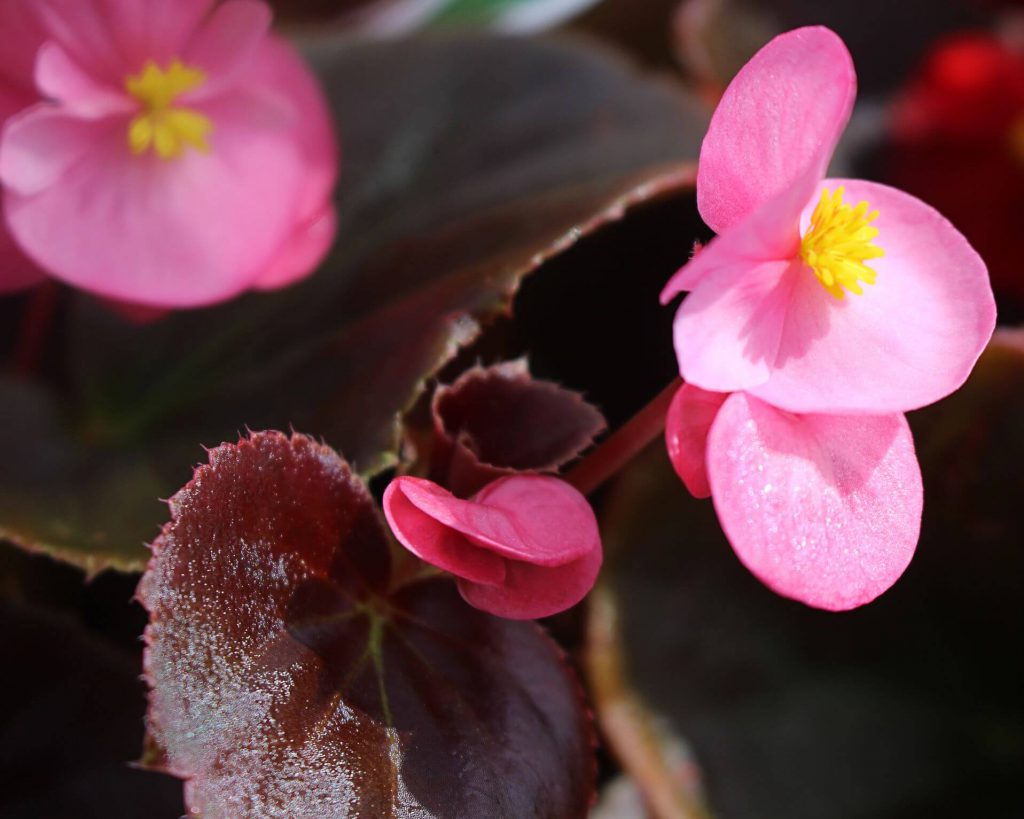By Ralph E. Mitchell
 Every plant has a history behind it. The poinsettia was named after Joel Poinsett, U.S. Ambassador to Mexico. The genus of the African violet is Saintpauli named after Baron Von Saintpaul. The begonia was discovered in 1690 in the tropical New World by Charles Plumier who named it after the person who supported his expedition, Michel Begon. The bushy fibrous-rooted plant is now known as the wax begonia or Begonia cucullate. While there are so many types of begonias to choose from including fibrous-rooted, rhizomatous, and tuberous, this article will concentrate on the fibrous-rooted ones we call wax begonias. This super-popular houseplant, holiday plant and bedding plant has leaf form and flower color to satisfy all tastes.
Every plant has a history behind it. The poinsettia was named after Joel Poinsett, U.S. Ambassador to Mexico. The genus of the African violet is Saintpauli named after Baron Von Saintpaul. The begonia was discovered in 1690 in the tropical New World by Charles Plumier who named it after the person who supported his expedition, Michel Begon. The bushy fibrous-rooted plant is now known as the wax begonia or Begonia cucullate. While there are so many types of begonias to choose from including fibrous-rooted, rhizomatous, and tuberous, this article will concentrate on the fibrous-rooted ones we call wax begonias. This super-popular houseplant, holiday plant and bedding plant has leaf form and flower color to satisfy all tastes.
Wax begonias have traditionally been a plant best adapted for shade. Plant breeders now have varieties that not only tolerate the sun, but also do better in the sun. Modern bedding wax begonias do well in the Florida climate as they can withstand drought and heat better than some annuals such as petunias. Begonias are great for garden beds in our area for fall planting. They tend to be slow growers, which keeps them in bounds so that they can be planted relatively close together. Besides flowerbeds, begonias also do well in window boxes, pots and hanging baskets. Most gardeners use wax begonias as an annuals, although they can live for several years. With either bronze or green foliage, both single- and double-flowered types are available and come in red, pink, and white. Wax begonia plants are readily available at any garden center.
Well-drained organic soil is a must for wax begonias. If needed, add up to fifty-percent organic matter such as peat moss, compost or well-rotted manure. Fertilizer at planting time may be used sparingly if at all, as begonias are not heavy feeders. Post planting fertilizer needs should also be light. Plant begonias in beds eight to twelve inches apart. Potting up begonias instead of putting them in beds has several advantages to consider such as reduced nematode damage, less fertilizer and water requirements.
A small postscript to mention. Believe it or not, technically, Begonia cucullate, the wax begonia, is classified as a CATEGORY II Invasive plant which means according to the Florida Exotic Pest Plant Council (FLEPPC) that “Invasive exotics that have increased in abundance or frequency but have not yet altered Florida plant communities to the extent shown by Category I species. These species may become ranked Category I if ecological damage is demonstrated.” However, the UF/IFAS Assessment of Non-native Plants in Florida’s Natural Areas mentions that wax begonias can be used with caution – just prevent them from escaping. This is generally fairly easy as most wax begonias are kept in planting beds or containers. Also, I would imagine that the many modern hybrids and cultivars available are less of a problem in comparison to the original wild type sometimes seen in central and north Florida natural areas.
There are many wax begonias to choose from – too many to name or highlight. Visit your local garden center soon to check out your favorites! For more information on all types of begonias, please call our Master Gardener volunteers on the Plant Lifeline on Mondays, Wednesdays and Fridays from 1 to 4 pm at 764-4340 for gardening help and insight into their role as an Extension volunteer. Just as a reminder, our new office is located at the North Charlotte Regional Park at 1120 O’Donnell Blvd, Port Charlotte FL 33953. The Plant Lifeline is now open at our new site. Our phone numbers and email addresses continue to remain the same. Don’t forget to visit our other County Plant Clinics in the area. Please check this link for a complete list of site locations, dates and times – https://sfyl.ifas.ufl.edu/media/sfylifasufledu/charlotte/docs/pdf/Plant-Clinics-Schedule1.pdf. Our Eastport Environmental Demonstration Garden is always open to the public outside the gate at 25550 Harbor View Road and will continue to be in operation. Master Gardener volunteers tend this garden on Tuesday mornings from 8 to 10 am and are available for questions. Ralph E. Mitchell is the Director/Horticulture Agent for the UF/IFAS Charlotte County Extension Service. He can be reached at 941-764-4344 or ralph.mitchell@charlottecountyfl.gov.
Resources:
Black, R. J. & Tjia, B. (1991) Fibrous-Rooted Begonias for Florida, The University of Florida Cooperative Extension Service, IFAS.
FLEPPC 2019 List of Invasive Plant Species – http://bugwoodcloud.org/CDN/fleppc/plantlists/2019/2019_Plant_List_ABSOLUTE_FINAL.pdf
The UF/IFAS Assessment of Non-native Plants in Florida’s Natural Areas – Begonia cucullate. https://assessment.ifas.ufl.edu/assessments/begonia-cucullata/
Begonias. (2019) UF/IFAS Gardening Solutions. https://gardeningsolutions.ifas.ufl.edu/plants/ornamentals/begonias.html
Ginori, J., Huo, H. & Warwick, C. R. ( 2020) A Beginner’s Guide to Begonias: Classification and Diversity. The University of Florida Extension Service, IFAS.
Begonia cucullate – Center for Aquatic and Invasive Plants University of Florida, Institute of Food and Agricultural Sciences. https://plants.ifas.ufl.edu/plant-directory/begonia-cucullata/
 0
0
